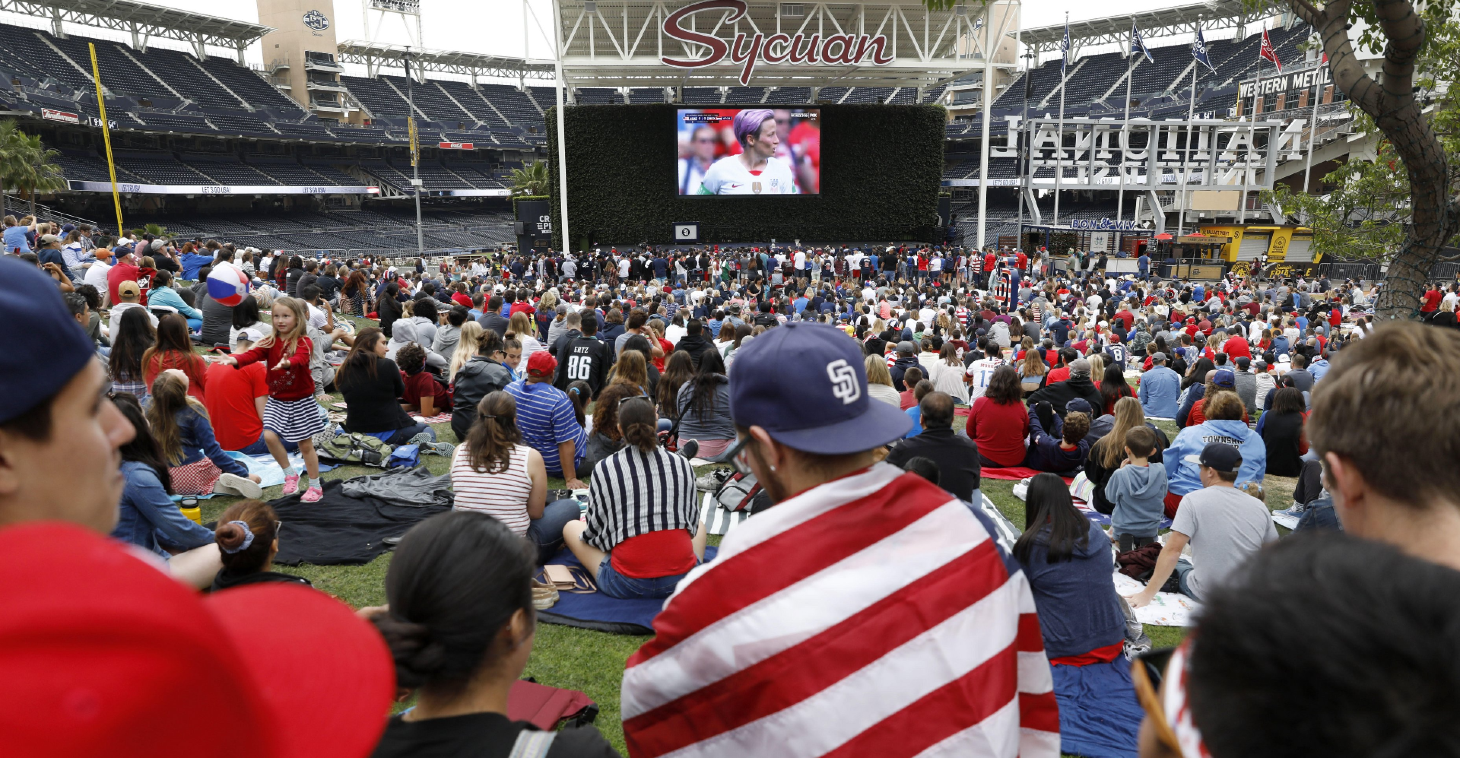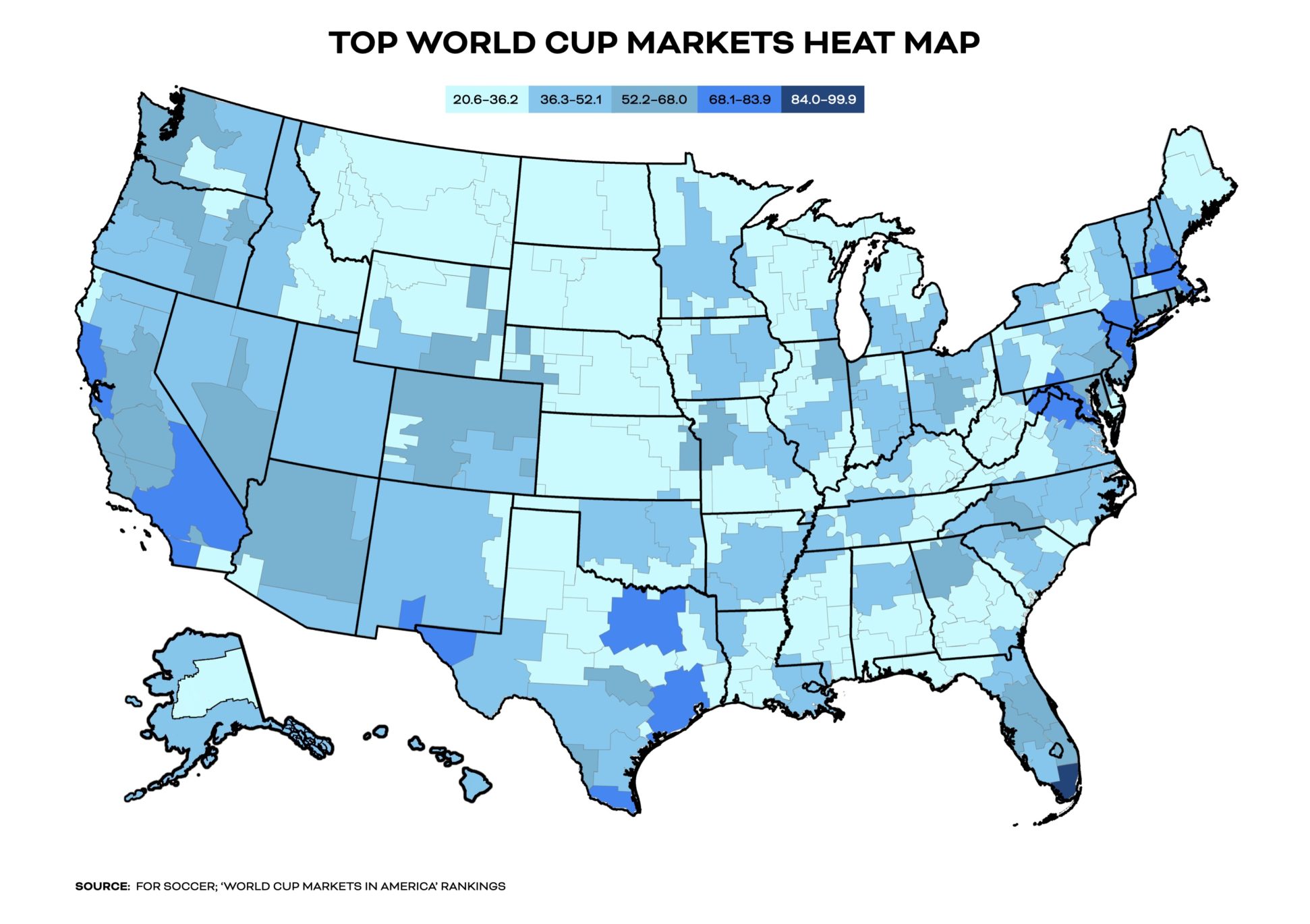
The 2026 FIFA World Cup is just around the corner, and soccer fever is building across North America. But which U.S. cities and regions in the U.S. are most excited about the tournament? We sought to find out which local TV markets might have audiences glued to their screens when the world’s biggest sporting event arrives.
This Was Our Approach
We didn’t just guess—we dug into some serious data via YouGov, MRI-Simmons, Nielsen, Google Trends, and more. We reviewed all 210 U.S. television markets as designated by Nielsen and measured their World Cup enthusiasm in several ways:
- How many people watch international soccer, past World Cups, and U.S. Men’s National Team games (weighted at 15%)
- How often locals search online for World Cup info, especially about 2026 (weighted at 35%)
- What people tell surveys about their World Cup interest (weighted at 10%)
- Local English- and Spanish-language TV ratings for the 2018 and 2022 tournaments (weighted at 40%)
We crunched these numbers into z-scores to understand their distance from the average, and then converted the results into an easy-to-understand 0-100 score. Think of it like a test score where 50 is average, 70+ is strong interest, and 90+ is World Cup crazy.
Additional note: one future consideration, in addition to a potential shortcoming of using DMAs mentioned later, is that applying the largest portion of weighting to 2018 and 2022 World Cup ratings doesn’t give enough credence to more recent data points. While true, we believe historic viewership is the best indicator of a market’s 2026 potential.

America’s World Cup Hotspots: The Top 10
Looking at the data, some clear frontrunners emerge:
Miami is in a league of its own—it’s like the city was built for World Cup viewing! With its incredible mix of cultures, especially its large Hispanic and Latin population, Miami combines all the right ingredients for World Cup obsession. And the numbers for Spanish-language broadcasts there are off the charts.
What else stands out among the top 10? New York and Los Angeles are the only other markets scoring above 80 points. These big media centers benefit from their melting-pot populations. And California and Texas have a strong showing, each with three markets in the top 10.
World Cup 2026: America’s Moment is Here
The countdown to kickoff is on! To continue the excitement, we recently published a mini report on the World Cup and America’s growing excitement, with insight into an audience growing in diversity, the motivations behind why fans root for certain national teams, and more. Click below to dive in!
The Next Tier: Markets 11-25
These next-tier markets show more variety. California continues to flex its soccer muscles with four markets making the list, with Texas (3) and Florida (2) also having multiple among the top 25. Several 2026 World Cup host cities appear here too—Seattle (#15), Philadelphia (#22), and Atlanta (#23).
America’s World Cup Heat Map

When we plot all markets on a map, several patterns emerge among the hottest World Cup regions:
- California is a soccer hotbed: it’s an obvious insight, but nearly the entire state shows above-average enthusiasm, from San Diego through the Central Valley to the Bay Area
- Texas is a powerful southern anchor: with intense concentration along the Mexican border and major metropolitan areas throughout the state
- The South through Northeast corridor has major impact: the connected band from Washington, D.C. to Boston often steals headlines, but the band of average to above-average interest extends well into the South
- Florida’s peninsula lights up: particularly around Miami, Orlando, and Tampa
The contrast between these soccer hotspots and the cooler regions (particularly in the Mountain West, Plains states, and parts of the South) is noteworthy. The heat map reveals that soccer interest follows specific cultural and demographic patterns and it’s not just about big cities.
Although one shortcoming of using DMAs is the expanse of some market areas where borders may be vast, but population centers are much more concentrated. Parts of the Southwest and the Plains states are good examples of this.
Key Insights From Our Analysis
Here are some takeaways from our rankings of the top World Cup markets in America:
Hispanic communities are major driving force: There’s undoubtedly an impact made by Hispanic-heavy communities, from Miami to Houston and Laredo to Los Angeles… and well beyond
Geography Matters: The soccer map of America has clear hot zones, including the southern border (and Southwest in general), California, the Northeast, and Florida. But other portions of the Midwest, Great Lakes, the South, and Pacific Northwest benefit from having well-established professional teams and soccer cultures ranging from well-established to maturing
Market Size Doesn’t Determine Success: Small and medium markets can compete with major metro areas through passionate local soccer cultures and strong community engagement. Look to El Paso, Harlingen, and Yuma as examples
Two Languages, Two Different Stories: Some markets are English-broadcast powerhouses but struggle with Spanish viewership, while others show the opposite pattern. Few markets dominate both—New York and Washington, D.C. are two examples that do
The Big Picture
As North America gets ready for the soccer world’s biggest party in 2026, these rankings show us where the largest groupings of the most enthusiastic fans might be. The American soccer landscape has changed dramatically since the last time we hosted in 1994, as the sport and the tournament’s popularity has spread from a few soccer hotbeds to a diverse map of passionate communities across the country.
What’s exciting is seeing how widespread World Cup interest has become. Yes, Miami, New York, and Los Angeles remain soccer capitals of America, but strong enthusiasm extends across the country in a vastly different way than it did 32 years ago.